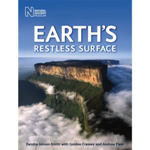Earth’s Restless Surface
Deirdre Janson-Smith, Gordon Cressey, Andrew Fleet
Published by: The Natural History Museum, London
Publication date: 2008
ISBN: 13 978 0 565 09236 8
List price: £9.99
111 pp

This is a well-written book illustrated with large, attractive, relevant photographs and clear explanatory diagrams - good value at £9.99. It is suitable for someone starting a study of geology or physical geography, such as an A/AS level student, first-year undergraduate or just anyone who is interested in how the world works.
The book begins with a general discussion of geology including uniformitarianism, the history of geology, plate tectonics, timescales and change. It goes on to discuss climate, the atmosphere, the biosphere, the hydrosphere including ocean currents, and the solid crust, including landslides, volcanoes and earthquakes, concepts of time and scale vs. change. It compares forces (such as ice) that act slowly and continuously, with forces such as landslides, hurricanes and tsunamis which can act rather more quickly.
The authors also consider the processes that give rise to sediments - weathering, erosion and deposition - and go on to consider the landscapes formed from these and other rocks. A desert landscape, a coastal landscape, an ice-formed landscape and a living landscape (coral reef) are given as examples. A brief history of plate tectonic movements covering the last 500 million years is provided, as are brief explanations of some famous geological localities in the UK.
As in many geology books at the moment there is a discussion of climate change but decides that as many factors are involved it is difficult to draw many firm conclusions about the future development of the climate. The book describes the value of computer models in predicting future atmospheric changes being brought about by burning fossil fuels. The authors conclude that at the beginning of the 21st Century the link between carbon dioxide (and other greenhouse gases) and global warming lies beyond reasonable doubt. How the pace of that change can be slowed will partly depend on technological advances, but above all else will be a matter of individual and political will.
Steve Rowlatt, Bishop’s Stortford